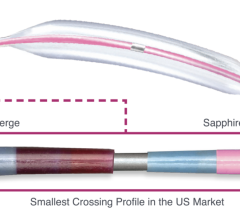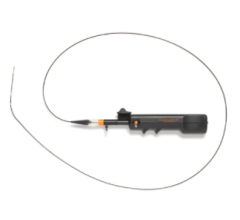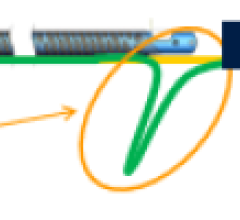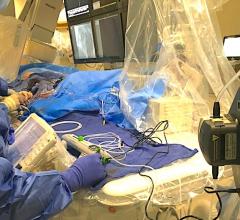
A comparison showing angiography and optical coherence tomography (OCT) views of an undilated mid right coronary artery calcified lesion, post dilation with the Shockwave intravascular lithotripsy system, and the final result after stenting. The technology allows calcified lesions to be broken up without the need for vessel trauma caused by high pressure balloons or atherectomy.
February 17, 2021 — The U.S. Food and Drug Administration (FDA) has cleared Shockwave Medical's Intravascular Lithotripsy (IVL) system to treat severely calcified coronary artery disease.
The innovative technology, which was granted Breakthrough Device designation by the FDA, is a novel application of lithotripsy, an approach that has been used for decades to safely break up kidney stones. With this approval, IVL is now commercially available in the United States to treat problematic calcium in the coronary arteries, which can reduce blood flow in the heart.
As coronary artery disease progresses, plaque in the arterial wall often evolves into calcium deposits, which narrow the artery and restrict blood flow. These bone-like structures make the artery rigid and more difficult to reopen with conventional treatments. The current standard of care for calcified lesions is using angioplasty balloons to attempt to crack the calcium when inflated to high pressures. The other alternative is atherectomy, which drills through the calcium and cuts away the calcium embedded in the vessel wall. Both treatments can lead to scar tissue growth because they raise trauma to the vessel wall. While atherectomy has been available for several decades, its use remains low, despite the high prevalence of calcium, due to its complexity of use and potential to result in adverse patient outcomes.
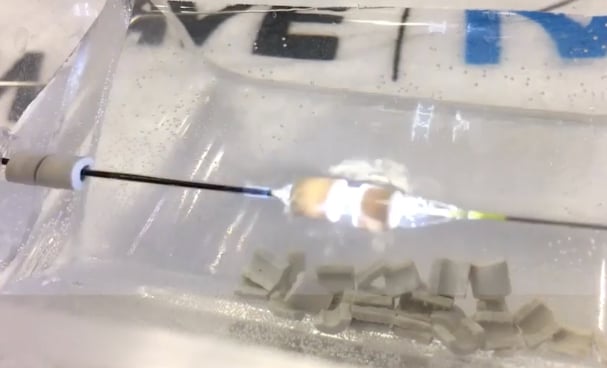 Intravascular Lithotripsy uses sonic pressure waves, also known as shockwaves, that pass through soft arterial tissue and preferentially disrupt calcified plaque by creating a series of micro-fractures. After the calcium has been cracked, the artery can be expanded at low pressure and a stent safely implanted to improve blood flow, with minimal trauma to normal arterial tissue. The coronary technology has been widely adopted internationally and is now available in 50 countries, with more than 25,000 patients successfully treated since the initial commercial availability in early 2018.
Intravascular Lithotripsy uses sonic pressure waves, also known as shockwaves, that pass through soft arterial tissue and preferentially disrupt calcified plaque by creating a series of micro-fractures. After the calcium has been cracked, the artery can be expanded at low pressure and a stent safely implanted to improve blood flow, with minimal trauma to normal arterial tissue. The coronary technology has been widely adopted internationally and is now available in 50 countries, with more than 25,000 patients successfully treated since the initial commercial availability in early 2018.
Watch a quick VIDEO demonstration of this technology.
“Coronary calcification is a major challenge for physicians because it limits the success of coronary angioplasty procedures and our current tools for addressing calcium have limitations,” said Dean Kereiakes, M.D., FACC, FSCAI, president of The Christ Hospital Heart and Vascular Institute, professor of clinical medicine, The Ohio State University, and the co-principal investigator of the pivotal Disrupt CAD III U.S. study.[1] “This approval represents a major advance in both the safety and simplicity of some of our most challenging procedures – and potentially promises to become a new standard of care.”
Watch a VIDEO Interview with Kereiakes on the key clinical data that led to the FDA clearance.
The approval comes on the heels of its U.S. pivotal study recently published in the Journal of the American College of Cardiology (JACC),[1] which confirmed that coronary IVL met both the primary safety and effectiveness endpoints with a low rate of major adverse events and a high rate of procedural success. Notably, coronary IVL was simple to use and demonstrated a low risk of rare but life-threatening complications that have been associated with the use of high-pressure balloons and atherectomy technologies, including tears in the artery, abrupt arterial closure and a sudden stop of blood flow.
“Obtaining FDA approval for this transformational technology marks a significant advance in the treatment of patients with calcified coronary lesions, and is the culmination of years of technical research, rigorous clinical studies and key learnings from our real-world global experience,” said Doug Godshall, president and chief executive officer of Shockwave Medical. “We are eager for U.S. cardiologists to have access to this technology and experience how a safe, efficient and predictable calcium modification strategy can positively impact their clinical outcomes.”
The Shockwave IVL System with the Shockwave C2 Coronary IVL Catheter is indicated for lithotripsy-enabled, low-pressure balloon dilatation of severely calcified, stenotic de novo coronary arteries prior to stenting in the United States. The technology has been cleared for the treatment of peripheral arterial disease in the United States since 2016.
For more information: https://shockwavemedical.com/
Related Vascular Lithotripsy Content:
VIDEO: Intravascular Lithotripsy to Treat Severely Calcified Coronary Artery Lesions — Interview with Dean Kereiakes, M.D.
VIDEO: Clinical Example of Coronary Lithotripsy to Break up Calcified Lesion
VIDEO: Demonstration of Intravascular Lithotripsy Breaking Up Calcium
Intravascular Lithotripsy: Will This New Investigational Technology Crack Calcium’s Code in the U.S.? — Article by DISRUPT CAD III investigators Dean Kereiakes, M.D., and Jonathan Hill, M.D.
FDA Grants Shockwave Medical Breakthrough Status for Coronary Intravascular Lithotripsy
Shockwave Announces Collaboration With Abiomed on Physician Training
Intravascular Lithotripsy May Offer Solution for Calcified Coronary Lesions — Article By Azeem Latib, M.D.
VIDEO: Breaking Up Calcified Lesions Without Vessel Trauma — Interview with Todd Brinton, M.D.
Lithotripsy Safe and Effective in Calcified Stenotic Peripheral Arteries
Watch the VIDEO How a Lithoplasty Balloon Shatters Calcified Plaque in Arteries With Ultrasound
Reference:


 November 08, 2024
November 08, 2024 
